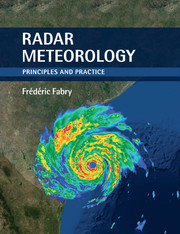Book contents
- Frontmatter
- Dedication
- Contents
- Preface
- Notation
- 1 Meteorology and radar
- 2 Fundamentals of weather radar measurements
- 3 Radar reflectivity and products
- 4 Reflectivity patterns
- 5 Doppler velocity information
- 6 The added value of dual polarization
- 7 Convective storm surveillance
- 8 Monitoring widespread systems
- 9 Radar estimation of precipitation
- 10 Nowcasting
- 11 Additional radar measurements and retrievals
- 12 Cloud and spaceborne radars
- 13 What does radar really measure?
- Appendix A Mathematics and statistics of radar meteorology
- References
- Index
10 - Nowcasting
Published online by Cambridge University Press: 05 June 2015
- Frontmatter
- Dedication
- Contents
- Preface
- Notation
- 1 Meteorology and radar
- 2 Fundamentals of weather radar measurements
- 3 Radar reflectivity and products
- 4 Reflectivity patterns
- 5 Doppler velocity information
- 6 The added value of dual polarization
- 7 Convective storm surveillance
- 8 Monitoring widespread systems
- 9 Radar estimation of precipitation
- 10 Nowcasting
- 11 Additional radar measurements and retrievals
- 12 Cloud and spaceborne radars
- 13 What does radar really measure?
- Appendix A Mathematics and statistics of radar meteorology
- References
- Index
Summary
Nowcasting needs and approaches
Almost everyone who has looked at a real-time animation of radar imagery has wondered: What is the weather going to do next and where is it heading? Will it reach my location? If yes, when, and for how long? Will the weather be severe? These are the questions that nowcasting systems and techniques are designed to answer.
For a variety of applications, very short-term forecasts of a few minutes to a few hours are needed. These may include the determination of the future track of a particularly severe storm for warning purposes, or the estimation of the amount of additional precipitation that will fall in a given area in the next few hours. Since weather varies rapidly in unexpected ways, such forecasts must be recreated often, typically several times per hour. Because numerical weather forecasting models must first wait several minutes for all the needed data to be available and then produce a correct analysis at the initial time before finally generating their forecast, they cannot at present satisfy our needs for very frequent forecast updates. Furthermore, they often do not perform very well for short lead times (Fig. 10.1). Therefore, there exists a niche for simpler and faster forecasting approaches.
Etymologically, nowcasting comes from the contraction of the words “now” and “fore-casting.” It refers to techniques dedicated to make forecasts over relatively short periods, generally with a lead time within 12 h. These are generally less complicated and designed to function more efficiently at short time scales than the traditional weather forecasting based on numerical modeling covering large portions of continents. For example, when we make a short-term forecast based on the pressure tendency of our home barometer, we are in essence performing a nowcast. Nowcasting techniques are particularly suited to use data from remote sensors such as radar and satellite.
- Type
- Chapter
- Information
- Radar MeteorologyPrinciples and Practice, pp. 166 - 179Publisher: Cambridge University PressPrint publication year: 2015



